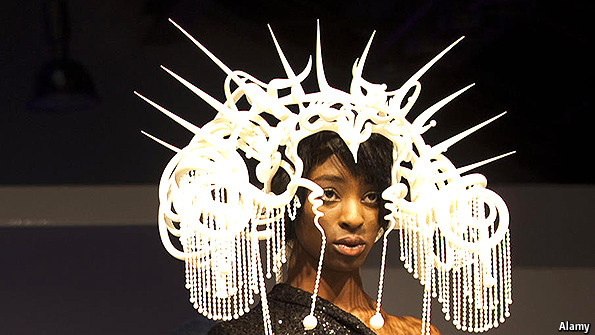Technology and fashion
Storming the maisons

correspondent writes, models are prancing down Parisian catwalks in fashion’s snootiest event, the presentation of the autumn and winter haute couture collections. This is where the creative directors of such houses as Chanel and Christian Dior get to show off pieces that are closer to art than to clothing and that influence the design of stuff that normal people might actually buy. But I recently attended a less-noticed event in Paris that sought to shake up the couturiers and everyone else at the gilded apex of the luxury establishment.
This was “Hackers on the Runway”, a conference put on by an outfit called The Family, which takes minority stakes in startups. The basic idea, put forward with revival-meeting fervour by speaker after speaker, is that disruption is coming to luxury and that the stodgy incumbents had better get out of the way if they can’t lend a hand. Most were too stodgy to attend such an event, so the disruptors found themselves mainly talking to each other.
Underlying it all was an interesting question: can technology disrupt luxury the way it has retailing or journalism, for example? The assumption among most of the attendees was yes, and there seemed to be plenty of evidence to prove it. Some of the new brands in the room would never have made it without the internet to broadcast their message. Julie Deane started the Cambridge Satchel Company in 2008 with £600 ($1,000) of capital but managed to get noticed by mail bombing bloggers and magazines, “building a community” and advertising through Google. Hannah Martin, which makes “androgynous” gold jewellery, finds customers and cultivates relationships with them largely through the internet.
But the disruptive notions went well beyond the idea of the internet as a shop window. There was much discussion of what role 3D printing might mean for luxury. Is it just for producing prototypes, or could it be used to fashion final products, or at least bits of them? What will happen to Swiss watches if smartwatches like Apple’s (supposedly) forthcoming iWatch become indispensable accessories? People are unlikely to wear one of those and a watch with Swiss complications at the same time, pointed out Richard Seymour, a product designer who gave one of the more rousing presentations. Geneva, which aspires to make watches that last for several lifetimes, can’t just strike back by stuffing them with the latest technology.
What about consumers using social media to demystify luxury brands? Seth Godin, a marketing guru, pointed to the case of NoKA chocolates, which sold for $850 a pound. It found itself in a sticky situation when bloggers claimed that its main ingredient came from a commercial supplier that sold it much more cheaply. “People who care are going to the edges”, Mr Godin proclaimed, which suggests a worrying future for big luxury brands.
The obstreperous story line was the dominant one. But there was an audible counter-narrative, which questioned whether luxury could really be disrupted in the same way as media and whether that would be a good thing. For one thing, the craftsmanship that underlies much of luxury relies on centuries-old, labour intensive techniques. If you apply too much technology, you lose what makes the product luxurious. Cutting-edge Hannah Martin makes its pieces by hand and collaborates with London’s Goldsmiths’ Company, which got its royal charter in 1327.
There was a surprising amount of resistance in this gathering of disruptors to the idea that what luxury brands should do is out-disrupt them. Mr Seymour’s advice, for example, wasn’t to change everything. Instead, he thought brands needed to express “longevity and invariable qualitative values” that are already embedded in their histories and products. The right response to change, he suggested, is to figure out what you are, and forge emotional links between that unchanging essence and the people you hope will buy your products.
This is at bottom a conservative message. It can lead to the further thought that luxury’s role is to resist rather than to celebrate the technological onslaught. That notion was put forward by Audrey Bartis, a semiotician. In her telling, as tech companies like Apple and Google gobble up more and more of the world, luxury companies stand out as doughty resisters, defending what is corporeal, natural and sensual. The battle, she suggested, would be fought out on the human body, now under siege from Google and its ilk in the form of wearable technology. In this fight luxury, whose territory is the body, may have home-field advantage.
It is easy to mock this sort of thing as typically French (imagine a semiotician at an Anglo-Saxon business event). But Mr Bartis may be on to something. Perhaps luxury is by nature a conservative phenomenon, and maybe that is one reason people value it. That doesn’t mean that luxury can’t and won’t be hacked, but it may mean that the hacking can go only so far

No comments:
Post a Comment